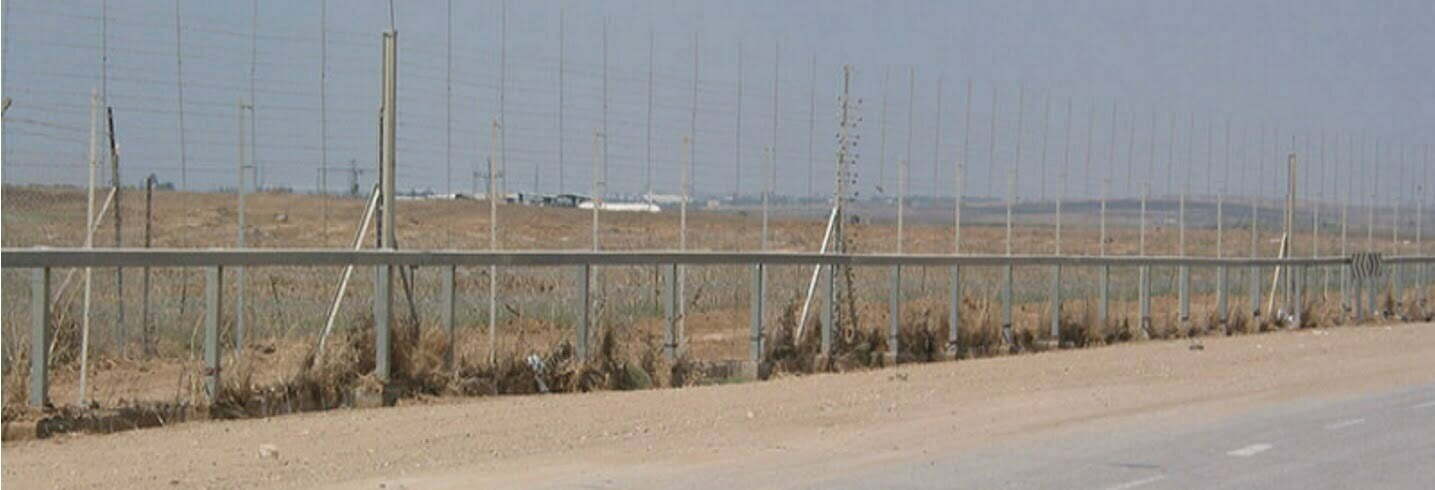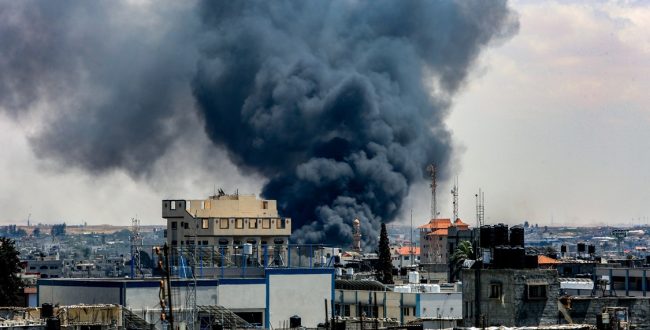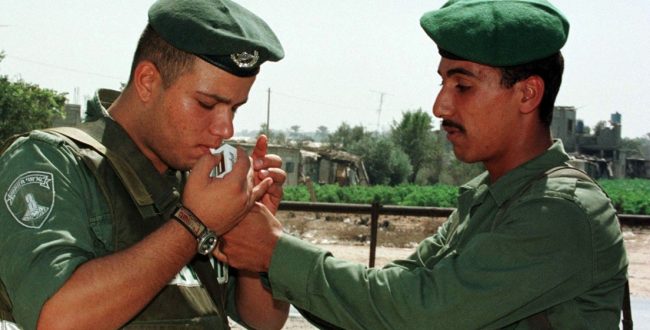Background
Yasser Arafat and Yitzhak Rabin signing the first Oslo Accord in September 1993 marked a turning point in Palestinian national history. The leader of the PLO recognized Israel and agreed to a reconciliation process that was supposed to lead to (partial) Palestinian sovereignty over less than a quarter of “historical Palestine”.
The Oslo Accords were a moral blow to the burgeoning Hamas movement formed only five years earlier. In its founding charter, Hamas rejected any territorial compromise in Palestine, calling it “an Islamic Waqf consecrated for future Moslem generations until Judgement Day”. Arafat may have laid down his arms (in a sharp departure from 1964 PLO charter) but Hamas saw holy jihad against Jews in Palestine as the personal duty of every Muslim.
Nonetheless, Hamas did not directly confront the PLO about the Oslo Accords. Pragmatically reasoning that it did not represent most Palestinians, the movement supported the establishment of a Palestinian state in part of “historical Palestine” as the first step towards liberating the entire land. It even agreed to the PLO’s proposal of temporary international supervision over the West Bank and the Gaza Strip until elections were held, so long as the Palestinian leadership did not recognize Israel. The spiritual leader of Hamas, Sheikh Ahmad Yassin, did not rule out the possibility of select Palestinian representatives negotiating with Israel after its withdrawal (rather than before as a precursor to the withdrawal, as favored by the PLO). Unlike the Muslim Brotherhood, which attacked the secular regimes in Egypt and Syria for representing the Jahiliyyah (the pre-Islamic period of ignorance), Hamas kept the debate civil and did not denigrate the PLO as it was clearly at a disadvantage.
The far-reaching concessions in the Oslo Accords (from a Palestinian perspective) boosted support for Hamas on the Palestinian street, especially among lower-income sectors and refugees. The movement’s charity and indoctrination network, known as dawah organizations, played a major role. “The more Yasser Arafat and his corrupt Palestinian Authority shirked their public duty, the more favor Hamas’ institutions curried as the alternative to power”, wrote Israeli journalist and researcher Shlomi Eldar. In the late 1990s, Arafat and his head of intelligence in Gaza, Muhammad Dahlan, tried to contain Hamas violence by bringing members of the movement into PA apparatuses. Israel’s defense establishment opposed this tactic and demanded that Arafat quash Hamas. With Israeli support and against the counsel of top PLO member Mahmoud Abbas, who was in favor of integrating Hamas into the PA, the movement’s image as an extra-parliamentary terrorist organization took root.
Another turning point was January 2006, when Hamas first decided to participate in the Palestinian general elections and beat Fatah. Hamas’ Change and Reform Party won 74 of 132 seats in the Palestinian Legislative Council, and Fatah only 45. After the elections, Ahmad Qari’ (Abu Alaa) stepped down as prime minister and was replaced by senior Hamas member Ismail Haniyeh, who formed a government that Fatah refused to join.
Read Gaza Paper I: “Hamas and the Arab Spring”
Ehud Olmert’s government in Israel clamped down quickly on Hamas and the PA. A few days after the election, Olmert barred Hamas members of parliament travelling between Gaza and the West Bank. Israel also froze the transfer of the taxes it collected for the PA unless it could receive assurance the money would not fund terrorism. These steps were backed by the international community and especially by the US, which refused to recognize Hamas unless it accepted the peace terms laid out by the International Quartet: recognizing Israel, abandoning the armed struggle and honoring previous agreements, including the Oslo Accords and Bush’s road map.
Relations deteriorated further after Israeli soldier Gilad Shalit was abducted from the border with Gaza in June 2006. Olmert’s government refused to negotiate his release with Hamas and launched Operation Summer Rain: a ground invasion and airstrikes on Gaza. The mutual fire lasted intermittently for five months, killing five Israelis and 394 Palestinians. In the West Bank, Israel arrested dozens of Hamas operatives, including 20 members of parliament and eight government ministers.
Although the conflict escalated between Fatah and Hamas forces in Gaza in February 2007, the rival parties signed the Mecca Agreement to ease international sanctions on the Hamas government. Prime Minister Haniyeh stepped down and was reappointed by President Abbas to lead a unity government. Yet the fragile union was short-lived: Hamas forcefully took control of Gaza in July 2007 and banished Fatah members in a bloody exchange. Since then, despite repeated attempts at reconciliation mediated by Egypt and Qatar, the split between the two rivals has defined the crisis in Palestinian politics. It has paralyzed the legislative system and blocks serious progress in negotiations with Israel.
Why Hamas succeeded in Gaza
Several factors combined to enable Hamas’ takeover and ongoing control of Gaza. First, out of 1.9 million Palestinians in Gaza, 1.4 million are registered as refugees with UNRWA. The population of Gaza is extremely poor compared to the general Palestinian population, and is only tenuously attached to the place. Utter dependency on international aid and unemployment – countered by hollow promises by leaders to fulfil the right of return – have spawned deep bitterness towards the PA, in one of the world’s most densely-populated areas.
Second, Muhammad Dahlan’s security services punished Hamas severely for terror attacks against Israel in February and March 1996, engendering feelings of humiliation and injustice that fed into the image of Hamas as an underdog bullied by the PA. Arafat changed his soft tack on Hamas not only because Israel pressured him heavily, but also because he received intelligence that Hamas was planning a coup and even to assassinate him. After the harsh terror attack in the heart of Tel Aviv on 4 March 1996, Arafat’s men arrested the Hamas leaders in Gaza: Mahmoud a-Zahar, Abdelaziz Rantisi and Said Sayyam, as well as rocket developer Adnan al-Ghoul.
Shlomi Eldar writes:
The underground detention cells in the Preventive Security headquarters in Gaza, the cells in the Gaza prison once run by Israel, and the cells in Junaid prison in Nablus, are all full to bursting. I personally saw them filled with long-bearded men when I went to the Gaza prison to film a news story. Hamas and Jihad military operatives were being held in Dahlan’s basement, while the political leaders were held in the basement of the general security branch headed by Arafat’s reviled nephew, Moussa Arafat. The PLO chief and his nephew, along with the heads of the security services, did not yet fear Palestinian public opinion. Arafat could now hurl the terrible charge of treason back at his accusers. In an exceptional move, his nephew shaved off the beards of Dr. Mahmoud a-Zahar and Ahmad Bahar. Removing the beard of a devout Muslim is considered an unforgivable sin. A-Zahar and Hamas have never forgot the humiliation and vowed to get their revenge on Moussa Arafat, Yasser Arafat and Muhammad Dahlan one day.
added to this was the corrupt image of the Palestinian Authority. In a 2017 survey published by AMAN, the Palestinian branch of Transparency International, Palestinians ranked corruption the second most severe problem in the PA, just under the economic crisis and far above the Israeli occupation. According to another recent survey, carried out by Khalil Shikaki’s center in Ramallah, 77% of respondents believe PA institutions are corrupt and half see the PA as a burden, as opposed to only 44% who believe it is an asset. Almost 75% believe the situation is worse now than before the Oslo Accords.
Read Gaza Paper II: “Hamas – from opposition to government”
Israel encouraged Palestinian split
Under the Oslo Accords, Israel recognized the West Bank and Gaza as a single territorial unit in which the Palestinian people can fulfill their right to self-determination. In 2002, Israel’s High Court of Justice reinforced this principle in a nine-judge panel, ruling that forcible transfer of civilians from the West Bank to Gaza is not expulsion but “relocation within the same occupied area”.
However, the “safe passage” between Gaza and the West Bank – a highway that Israel agreed to under the Oslo Accords – operated for a year only: from October 1999 to October 2000, when the second intifada broke out. In 2000, Israel decided to stop updating address changes between Gaza and the West Bank in its copy of the Palestinian population registry. In 2011, it announced it would allow 5,000 Palestinians to change address from Gaza to the West Bank. However, Israel retained the ability to detain many Palestinians who live in the West Bank on grounds of illegal presence there, based on a population registry not Updated for twenty years. In practice, therefore, Israel began separating between the two Palestinian territories almost seven years before Hamas took control of Gaza.
The separation between Gaza and Israel (and the West Bank) took on physical form with the construction of the perimeter fence around Gaza, launched in 1994 and completed in 2005. Meanwhile, the Separation Barrier was erected in the West Bank. In 2005, Israel unilaterally withdrew from Gaza and in its view removed the legal impediments binding it is an occupying power.
However, after the Hamas takeover in 2007, Israel imposed a series of restrictions on Gaza. It shut down Karni Crossing and forbad exports, greatly limited imports, and reduced the amount of fuels and food allowed in to Gaza. Movement between Gaza and the West Bank was limited to “exceptional humanitarian cases”. After Operation Protective Edge in 2014, Israel permitted some sale of Gazan goods in the West Bank and in Israel (during the shmita year of 2015), and slightly increased the number of permits issued Gazans to enter Israel for family visits or prayer.
Since 2010, Israeli defense officials have called this the “separation policy”. In a document dated December 2010, the Coordinator of Government Activities in the Territories (COGAT) wrote: “In 2006, a decision was made to introduce a policy of separation between the Judea and Samaria Area and the Gaza Strip in light of Hamas’ rise to power in the Gaza Strip. The policy currently in effect is aimed at reducing travel between the areas” (in fact, Hamas took over the Gaza Strip in 2007). Several months earlier, COGAT Eitan Dangot testified before the Turkel Commission that “separating Gaza from Judea and Samaria is an extremely important security conception”. He did not elaborate why. According to information the military provided Israeli human rights organizations Gisha and HaMoked – Center for the Defence of the Individual, from 2011 to 2014, 58 requests by Palestinians to relocate to Gaza were approved, subject to signing a pledge declaring that they knew they would not be allowed to return to the West Bank.
The separation policy was enthusiastically backed by rightwing politicians in Israel. In a March 2012 speech, Defense Minister Avigdor Lieberman said:
The ongoing firing [from Gaza] is burying any possibility of future territorial contiguity between Gaza and Judea and Samaria. As long as Hamas controls Gaza, there is no chance that we will agree to safe passage, unsafe passage, overland passage, underground passage, or any kind of passage at all. The Palestinians have sentenced themselves to isolation that currently looks set to last for generations to come.
According to Naftali Bennet’s ‘stability plan’, too, Gaza will be entirely cut off from the West Bank, so as not to “channel Gaza’s problems into quiet Judea and Samaria”. Unlike Gaza, whose border with Israel will be hermetically sealed, in the West Bank Bennett promises “smooth transport connections” in which “any resident will be able to reach any spot in Judea and Samaria without seeing a single IDF checkpoint”.
Clearly, the “separation policy” is far from being a matter of security only. It serves rightwing politicians to prevent the unification of the two Palestinian territories under a single leadership. These politicians know all too well that such unity would necessarily draw international pressure on Israel to renew negotiation over the two-state solution.
The Palestinians want unity, yet their leaders refuse
The Palestinians know that the political rift between Fatah and Hamas, and the divide between the West Bank and Gaza, is blocking meaningful gains regarding Israel. Time and again in the last ten years, thousands of Palestinians have taken to the streets demanding unity. However, they have come up against an Israeli refusal to negotiate as long as the PA is discussing a national unity government with Hamas. According to a December 2018 survey by Khalil Shikaki’s center, two-thirds of Palestinians are not pleased with Rami Hamadallah’s technocratic government. A similar number is not optimistic about the reconciliation efforts between Fatah and Hamas.
Mahmoud Abbas heeds public sentiment, but appears to have given up all hope of unity. In recent years he has taken every measure within his (admittedly limited) power to topple the Hamas government. Although he criticized the US decision to declare Hamas a terror organization in December 2018, stating that “the Hamas movement is part of our people and I do not agree that terror be ascribed to it”, in reality he has worked to crush it. For example, Abbas has withheld financing for transferring patients from Gaza to the West Bank, for the wages of PA officials in Gaza and for Gaza’s electricity bill, going on withdraw his forces from Rafah Crossing in January 2019 as an act of defiance against Hamas. His right-hand man, top Fatah member Azzam al-Ahmad, even threatened to stop the issuance of passports and high-school diplomas for Gazans as a step towards declaring Gaza a “rebel zone”.
Summary
In his 2009 election campaign, then-head of the opposition Binyamin Netanyanu promised “to destory Hamas’ reign of terror”. In his ten years as prime minister since, he has done no such thing. In fact, Netanyahu recently authorized the transfer of millions of dollars from Qatar to Gaza in cash-laden suitcases. The “separation policy”, conceived originally as a security solution, has found its way into the political programs of his partners in government.
“The IDF can only destroy Hamas with a government okay”, admits Ariel Kahana of Israel Hayom. “Yet the question troubling both the government and the military is, ‘who will take its place?’ […] The PA or Fatah will never agree to regain control of Gaza thanks to IDF force […] That is why there is no realistic scenario in which the PA returns to Gaza.”
Actually, Kahana’s suggestion has never been seriously examined – at least, not in public. Netanyahu has never declared support for the PA returning to Gaza, and the Palestinian leadership in Ramallah has never been (publicly) asked to retake Gaza with Israel’s open or covert aid. All signs indicate an eager affirmative, should the question ever be posed. “Netanyahu is personally funding Hamas and we’re paying the price”, lamented Abbas in a speech before the PLO leadership in Ramallah following terror attacks against Israelis in the West Bank.
If Israel declares it is willing to resume talks with a pragmatic Palestinian leadership that controls both Gaza and the West Bank, and does everything it can to advance that goal, it may very well find an enthusiastic partner in Ramallah. If the Palestinians then fail to agree on unity (as Israel would demand), the blame would shift from Israel to the Palestinians. For now, Netanyahu and his partners seem to view renewed negotiations as a threat rather than an opportunity, and will likely continue to stall in every way possible.


















